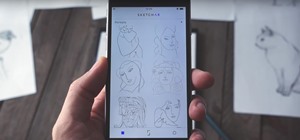You can almost detect the collective breath-holding of the augmented reality industry as it waits for Apple's inevitable entry. A new Apple wearable built with augmented reality technology is likely the device that will finally make the smartphone take a backseat.
Apple's forthcoming (though not officially announced) AR smartglasses will be the company's follow-up to its first wearable, the Apple Watch in 2015 (yes, that was only three years ago), and will set off a chain reaction in the smartglasses industry that's already begun in Asia.
Although devices like North's Focals — the closest example we've seen of fashionable, mainstream-friendly AR smart glasses (albeit only capable of 2D, non-immersive graphics) — have beaten Apple to the spotlight of public scrutiny, the wearable AR market is still Apple's to dominate. Essentially, North's Focals took the Google Glass concept and put it in a far more stylish frame. And while North's example might be the path Apple takes, it seems unlikely that the company would devote so much time and attention to ARKit — a platform that supports 3D, immersive AR content — and then release an AR wearable that doesn't truly take advantage of the developer community and apps developed using ARKit.

Therefore, if we're going to imagine what the next Apple wearable will look like, a better bet seems to be a cross between the design style of Focals and the Vuzix Blade and the feature execution of the Nreal Light, a device that's tethered to a tiny (170 gram) hip computer module or an Android smartphone to drive immersive AR experiences.
With the Nreal Light, the user has the powers of SLAM (simultaneous localization and mapping), object recognition, plane detection, and 6DoF tracking. I've used it, and while the field of view is somewhat limited, the experience is "good enough," and the only thing that's missing from the equation are apps and content. These are areas where Apple is well ahead in compared to any AR headset maker. Apple also happens to make one of the most powerful and popular hip computers on the planet, the iPhone.

A recent report from trust Apple analyst Ming-Chi Kuo indicates that Apple will indeed rely on the iPhone to drive its AR smartglasses. If that report is accurate, the Nreal Light, which hails from Apple's manufacturing base of China, might be a bulkier, Android-flavored preview of what's reportedly already in production over at Apple.
But let's stay in China for a moment.
Despite manufacturing many of the smartphones on the planet, initially, China played catchup in the smartphone wars, chasing Apple and Samsung for years before finally reaching some semblance of parity with regard to sales and product quality. With that mobile device gap now closed, don't expect China to lag in the realm of mobile AR hardware and software.

It's fascinating to listen to so much chatter about China's increasing competition with US smartphones, robotics, and AI, and find so little of that conversation mirrored in conversations about AR. China iterates rapidly, and experiments often. But part of what I learned from living in Asia for many years is that the West rarely pays close enough attention to what's happening on the ground in Asia tech.
Long before emojis and selfies became big in the US, sharing photos of your food and texting emoticons (the precursor to emoji) was old hat in Asia. Mobile culture in Asia had such a head start on the US that when the iPhone came out in 2007, some believed it would fail to gain popularity among an already invested and mature mobile-device savvy consumer base in Asia.
We now know that Apple eventually won Asia over, but the many lessons that early mobile giants like Docomo, Softbank, and SK Telecom learned and benefitted from weren't directly ported over to Western wireless players. Instead, those Western companies effectively started from scratch in their efforts to build and foster a mainstream mobile culture in the West.
The lesson? It's time to ditch our cultural myopia and pay attention to what's happening with AR in China.

If you want to know just how vital AR is to China, consider the fact that Nreal is backed by Beijing-based Shunwei Capital, a major investor in smartphone maker Xiaomi, and YouTube competitor iQiyi. Currently, Shunwei Capital manages over $3 billion — devoted largely to tech ventures. Another notable AR player in China is the BOE Technology Group, the state-owned company was one of the early backers of Meta Company and continues to operate in the mobile display, IoT, and augmented reality spaces.
Earlier this year, the company released a series of videos showing off its vision of how AR will soon be seamlessly integrated into the fabric of everyday life. And those are just a couple of players in the vast pool of tech-focused capital operating in Asia, focused, in large part, on AR.
So when Apple does reveal its long-rumored AR wearable, not only will there already be similar looking, Android-based competitors on the market in China (locally branded and as OEM options for international vendors), but whatever innovations Apple introduces to the glasses-connected-to-smartphone AR dynamic won't take years to copy, as it did with the iPhone. Instead, those innovations will be emulated and iterated upon even more rapidly than anything we've seen before with early iPhone competitors, because China is, at this point, technically the first mover for mainstream mobile AR.
I left the US to move to Japan in 2007, just before the launch of the iPhone. At the time, in the US, most of us were still obsessed with our flip phones, with only some opting to adopt devices like the Hiptop (aka Sidekick), the Blackberry, and some Palm Pilot die-hards still holding on via the Palm Treo. When I came back to the states in 2012, mainstream behavior had wholly changed. People were now walking off elevators and bumping into people with their heads buried in iPhones, and saying "#winning" had become a part of regular conversations. That's how fast technology changes human culture. Five years can shift the entire planet.
The same kind of tectonic shift is about to take place with AR via wearable devices. Devices like the HoloLens 2 and the Magic Leap One are showing us what the best versions of these AR experiences can be, but it will be the mobile wearables that truly act as the catalysts that bring about widespread change.
It didn't take us long to get used to sending pictograms instead of paper letters and still new-ish emails. Transitioning from Mapsco paper maps to mobile device GPS happened in the blink of an eye. And 2007, the last year Kodak turned a profit before going bankrupt in 2012, is the same year the iPhone began teaching US consumers to photograph "everything" daily.

And like the iPhone, and the Apple Watch after it, when Apple releases its AR wearable, there will be many doubters. When the Apple Watch came out in 2015, many reviewers panned it with lackluster reviews. Today, just three years later, in the US, you see the device on every other wrist, male or female, old or young, as the top-selling wearable.
There's no guarantee that Apple will be able to replicate this success when it debuts its AR wearable in 2020 (or 2021, at the latest), but it won't be alone.
Facebook has already tipped its hand that it has an AR wearable in the works. And while Mark Zuckerberg talks about putting a billion people in VR, his laser focus on mobile indicates that he knows AR is where Facebook's immersive future lies. Similarly, reports have pointed toward a Snapchat brand of AR smartglasses that would build upon the company's early experiments with Spectacles.

The game of AR thrones is afoot, but who gets to sit on the "iron throne" of our faces remains unclear. Nevertheless, tech history indicates, whether it's Apple or another company, we should all prepare for significant change.
Speaking to ghosts in public (AR avatars others can't see) and literal window shopping (buying localized virtual items without walking into stores) will be normalized. Instead of craning our necks down at tiny squares of glass (an incredibly unnatural act, when you think about it), we'll instead look up and around to compute and interact spatially.

It will feel simultaneously a lot more natural, and far more odd. When every inanimate object and surface has "living" interactive properties, a new world filled with magic — dark magic (AR cloud hacking, visual and audio data smog in real-world spaces), and good magic (overall convenience and a much smaller world) will arrive.
Since we're focused here at Next Reality on the near-term future of AR, I won't get into brain interface systems like Neurable and Neuralink, or AR contact lenses, but things are about to get weirder and move faster every year.
The negative and positive effects of smartphone culture that many have dissected and used to predict our collective future were just preparation for the coming deep strangeness of living in AR clouds via AR lenses that we take with us everywhere.
Perception: Smartglasses are just the latest Apple rumor. Today's major players will win the AR hardware wars.
Next Reality: Apple Glass is the next Apple Watch, but bigger, ARKit devs will be rewarded for their persistence on the platform. Their success will lead to a plethora of Android-based copycats.
This post was created as a part of our Future of AR series. View the whole series.
Just updated your iPhone? You'll find new features for Podcasts, News, Books, and TV, as well as important security improvements and fresh wallpapers. Find out what's new and changed on your iPhone with the iOS 17.5 update.






















Be the First to Comment
Share Your Thoughts